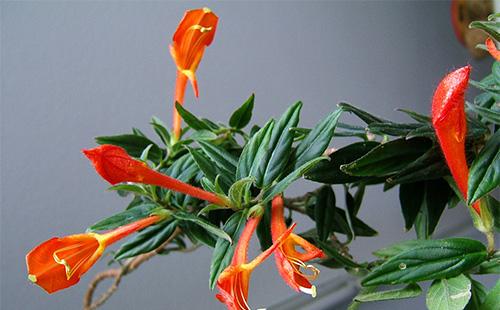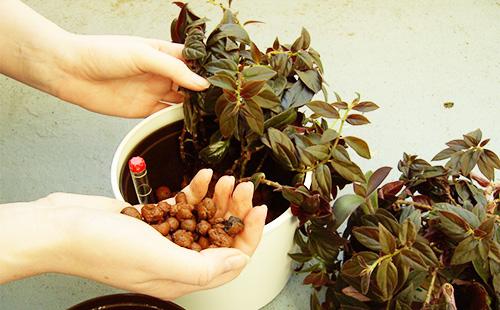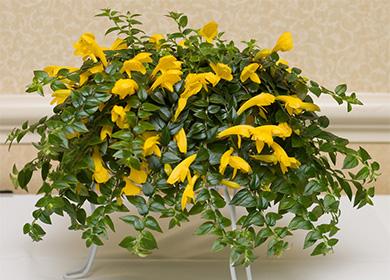The content of the article
The flower growers called the column “the goldfish” for the unusual shape of the flowers. Creeping liana grows quite quickly, forms beautiful lush bushes, which in winter or early spring are abundantly covered with buds.
Plant description
Columnia flower is a grassy perennial epiphyte. In nature, grows on the bark of large trees. The roots are fibrous, young shoots are straight, vertical, gradually lower under their own weight. Long lashes are densely strewn with medium-sized heart-shaped leaves on petioles. The surface of the foliage is glossy, sometimes with a slight pubescence.
It blooms in winter or March - in the southern hemisphere, summer begins at this time. Flowers-tubes are located on vines singly, bloom in the axils of the foliage. The greatest number of buds is laid in the middle of the lash. The flowers are quite large, two-lipped, in appearance a bit like orchids. In the natural color, yellow, pink and orange shades prevail.
Popular views
Columnae is a fairly large genus of ornamental plants. It has a little less than 200 varieties. Most of them are not adapted to the cramped conditions of the apartment. In pot culture, seven species are best known.
- Columnae Carnival. Vines are strewn with small, glossy leaves of saturated color. Flowering is plentiful and long. Flowers characteristic of the columna form: bright yellow, with a red edging.
- Kolumney Allen. Differs in creepers up to seven meters long. The leaves are dark, lanceolate, grow in pairs on the stem. Abundantly covered with red flowers.
- Kolumneya Krakatau. It differs in shoots raised from the root. The leaves are small, thin. The flowers are medium-sized, red-orange.
- Kolumna blood red. Shrub with large leaves and slightly flattened stems. The back of the leaves is decorated with red spots. The flowers are axillary, gathering several in small inflorescences.
- Columnae Banks. The vines are quite short - no more than one meter. The leaves are small, glossy. The flowers are large, yellow-orange.
- Kolumney glorious. The leaves are fleshy, pubescent. The flowers are large, orange-red.
- Kolumney Shida. Creepers are flexible, slightly pubescent with a reddish pile. In apartments, the length of vines does not exceed one and a half meters. Yellow flowers cover the vine along its entire length.
Columnia care and favorable microclimate
Care for the flower of the columna is aimed at creating a microclimate close to the natural conditions of growth.You can achieve favorable conditions in the apartment, but for this you will have to make some efforts.
- Lighting. Like most houseplants, colder need bright diffused light. Due to lack of lighting, the plant weakens. The most favorable location in the apartment is the western and eastern windows. On the south side they are always shaded. On the north side, it grows poorly - it stretches, does not bloom. In late autumn and winter, artificial lighting is installed.
- Temperature. In the warm period of the year, the Kolumna feels well at a temperature of 22 ° C to 27 ° C. Easily tolerates short heat up to 30 ° C. She does not have a pronounced resting period, but in winter, in the absence of artificial illumination, the temperature of the content is reduced to 16–18 ° C. This has a beneficial effect on flowering.
- Watering. Experienced flower growers recommend watering the columnar sparingly, avoiding stagnation of moisture and complete drying of the earthen coma. Use softened water at room temperature. During cool wintering, the number of waterings is reduced.
- Humidity. To maintain decorativeness, increase air humidity. Regular spraying with water is required, 2-3 ° C above room temperature. It is beneficial to periodically bathe under a warm shower, followed by drying in a warm, shaded area.
- Top dressing. A balanced complex fertilizer is applied twice a month. During cold wintering, feeding is stopped. If the columnae winter in the warmth, with artificial lighting, every three weeks it can be fed with a small dose of fertilizer.
- The soil. For planting, columnaeans use loose soil, which allows air and moisture to pass through well. The composition of the soil is not demanding liana - you can use a universal mixture with the addition of perlite. Columnia grows well in a mixture of deciduous land, peat and charcoal. The prepared mixture is sterilized before planting - kept in a water bath, in the oven or calcined in a pan.
- Transfer. Immediately after flowering, you need to transplant the column in another pot. Usually transplanted annually, sometimes once every two years. At the same time, strongly elongated shoots are cut. A layer of expanded clay or gravel is poured at the bottom of the pot.
Breeding methods
Columnae quite easily propagated by vegetative and seed method. Propagation by columnis by cuttings is much easier than sowing seeds. Experienced flower growers in reviews recommend that beginners use precisely the cuttings.

Cuttings
The most simple and effective way of reproduction. Cuttings are carried out at the very beginning of spring. Act in the following sequence.
- Cutting cuttings. Cut apical cuttings about 5 cm long. Use sharp sterile scissors or a knife.
- Preparation of cuttings. The lower leaves are cut off, leaving only the topmost pair. The slice is lowered into the "Kornevin."
- Rooting. The easiest way to root shoots is more colorful in a glass of water. Water is poured into the bottom of the glass, a tablet of activated carbon is placed, and apical shoots are placed.
- Landing. After two to three weeks, roots form. Cuttings are immediately transplanted into a permanent pot. They plant several pieces in one container, placing them closer to the edge.
Seeds
Growing columna from seeds is considered a more laborious way. Mostly used store planting material. It is better to buy seeds with a margin - they do not germinate well, seedlings often die during the cultivation process. To obtain strong plants, follow the following sequence of actions.
- Training. The soil mixture is composed of sand and peat. The soil is pre-sterilized, watered with fungicide.The resulting substrate is filled into a low container.
- Sowing. Seeds are sown, lightly sprinkled with soil on top. The container is immediately covered with a film. Keep in a warm place. The temperature inside the greenhouse should be kept at 23–25 ° C. The greenhouse is aired daily, if necessary, moisten the substrate from the spray gun.
- Seedling Care. Shoots appear in two to three weeks. In the initial stages of growth, seedlings need good lighting. The best option is to install a container under a daylight lamp. The soil is not allowed to dry, moisture stagnation is not allowed.
- Pick. At the stage of formation of three or four true leaves, seedlings need to be planted in pots. Planted immediately in a permanent place, so as not to disturb unnecessarily a young root system.
Consequences of florist errors
Kolumneya refers to those colors that need a special approach. It blooms only in favorable conditions, if you violate the rules of care, it quickly loses its decorative effect. Below is a table describing the main mistakes of gardeners.
Table - Common Florist Errors
| Description of the problem | Inaccuracy in leaving | Help the plant |
|---|---|---|
| Columnae does not bloom | - lack of light; - low humidity; - irregular watering; - winter is too warm; | - In order to force bloom, they arrange a forced rest period; - adjust the conditions of detention |
| Leaves turn yellow, fall off, ends wrap inward | - dry air; - drying of soil | - Regulate the watering mode; - more often sprayed, bathed in the shower |
| Spots appear on the leaves | - Sunburn; - watering with cold water | - Use water at room temperature; - shade from the sun |
| The tops of the shoots fade | - Drying of the soil in the summer | - More often watered; - increase the humidity in the room |

Common Diseases and Pests
Of the diseases, rot of rot is a particular danger to columnae. It is easy to recognize it - a fluffy coating appears on the stems and leaves. Gray rot develops with systematic waterlogging of the soil, lack of drainage. Treatment consists in removing the affected parts and spraying with systemic insecticides. It is advisable to transplant a flower, examine its root system - it can also be affected.
Of the pests, thrips, a spider mite, shields and aphids. From the table you can find out signs of damage and ways to destroy pests.
Table - Common Pests
| Pest | Signs of defeat | Methods of struggle |
|---|---|---|
| Shield | - Brown stumps of brown color appear on the stems and foliage; - even before the appearance of insects, sticky drops form; - the plant turns yellow, withers | - Column is mechanically cleaned of insects; - bathe in a warm shower; - processed by "Actellic" |
| Aphid | - Young leaves on tops of shoots are twisted; - foliage is covered with sticky aphid secretions; - soot fungus develops | - Cut the twisted tops; - sprayed with tobacco dust infusion or with a permethrin-containing agent |
| Spider mite | - Light specks appear on the foliage; - individual parts of the leaves discolor and dry; - the plant turns yellow, fades | - A columna is watered from the shower with warm water; - Increase humidity in the room; - processed by “Aktara” |
| Thrips | - At first silver stains appear on the foliage, then a continuous coating; - pollen is showered from flowers on foliage; - the petals become full of holes | Several times, at intervals of seven to ten days, they spray the IntaVir, Iskra, Aktellik |
It is not easy to take care of the column at home, but the efforts made pay off with bright, long flowering. This is one of the most beautiful ampel plants grown in room culture.

